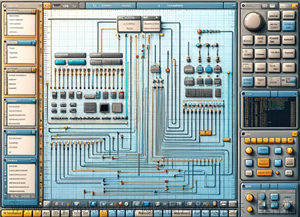Munandar et al. (2018) proposed a weather monitoring system by using automatic weather station [1]. The data logger and serial communication is used for data transmission, and kept in web server. Antony Jerome, et al. (2017) published a LabVIEW system using NI my Rio module for Autohome applications [2]. Weather analyzer by using LabVIEW is proposed by Damini H Patel et al. (2017) [3]. In this, Data is received through Wi-Fi and it is displayed on the computer with a Graphical User Interface and Internet on things. Pouyan Amirshahi et al (2017), proposed a RFI Radio frequency interference monitoring system for weather satellite ground stations [4]. Environmental monitoring system by using internet of things is presented by Jalpa Shah et al (2016) [5]. E. Kanagaraj et al (2015), presented a cloud-based remote environmental monitoring system with distributed WSN weather stations [6]. Embedded controlling system is designed and implemented by P.Susmitha et al (2014) [7]. It uses embedded environment for processing. Adelaide Memmo et al (2005), compared various meters of MM5 Integrated water vapor with Microwave Radiometer, GPS, and Radio sonde with measurements [8].
B. Proposed Working environment
In this, the work is carried out by using LabVIEW (Laboratory Virtual Instrument Engineering Workbench) software. It comprises built-in support of myDAQ data acquisition device hardware. NI Wireless sensor network is used for acquiring data of pressure, temperature and gas leakage. NI data dashboard is utilized for communicating alert signal in the form of files to mobile devices via SMS.
SECTION II.
SYSTEM DESCRIPTION
These systems comprised of various sensors, software, hardware, GSM (Global system for mobile communications) module for communication. The system block diagram is shown in figure 1. The sensor block diagram is displayed in figure 2. Hardware board is given in figure 3.
The pressure and humidity is obtained from the pressure sensor attached to my DAQ data acquisition (NI USB 6211) system. The flow of execution is determined by the graphical block diagram structure. It is the source code of the LabVIEW. The program is connected by different function nodes using drawing wires on the structures.
如今,天气预报已成日常生活中必不可少的内容。从报告中获取的信息用于分析和设置警报。开发一种基于LabVIEW软件的天气监测模型系统。它使用不同的传感器来测量温度、压力和气体检测等参数。在LabVIEW平台中安装了传感器,该系统获取分析并处理数据。创建一个包含数据的警报文件,并在任何参数超过设定点的限制时立即传达给相关人员。
监测天气环境是一项持续的工作,需要更早地预测环境状况。天气监测是自动化的,并在许多地方使用。环境变量,如地表温度、大气压力、湿度、风速、太阳辐射、液体降水,被用作气象站的输入。
数据记录器和串行通信用于数据传输,并保存在Web服务器中。统使用 myRio模块用于汽车家应用。数据通过Wi-Fi接收,并通过图形用户界面和互联网显示在计算机上。
LabVIEW软件进行包括对 DAQ数据采集设备硬件的内置支持。NI无线传感器网络用于采集压力、温度和气体泄漏数据。NI数据仪表板用于通过SMS将警报信号以文件形式传送到移动设备。
这些系统由各种传感器、软件、硬件、GSM(全球移动通信系统)模块组成,用于通信。
压力和湿度是从连接到数据采集(NIUSB6211)系统的压力传感器获得。

LabVIEW软件前面板温度指示,通过改变现实世界中的温度,温度计在LabVIEW面板上显示变化。Arduino IDE板是本LabVIEW中的软件需求,与Arduino接口。Arduino IDE启动,打开arduino文件,程序上传并关闭arduino IDE。
这些天气监测系统与arduino板连接。收集到的传感器输入被定向到DAQ硬件。它们与LabVIEW软件工具连接。与LabVIEW连接的GSM模块获取数字信号,并通过短消息服务发送给相应的移动用户。
气体传感器显示高达500级,它是水平线,之后它给出更多的振幅信号。

在LabVIEW开发气体检测、压力测量、温度的天气监测系统,这是LabVIEW的一个简单应用,更多的开发案例,欢迎登录公司网站,了解更多信息。
厂家有提供LabVIEW的例子。根据通讯协议的相关的说明,编写了适合项目的程序。程序截图如下所示。文章来源:https://www.toymoban.com/news/detail-478670.html
相关资料说明,如下所示。文章来源地址https://www.toymoban.com/news/detail-478670.html
到了这里,关于LabVIEW编程开发天气监测系统的文章就介绍完了。如果您还想了解更多内容,请在右上角搜索TOY模板网以前的文章或继续浏览下面的相关文章,希望大家以后多多支持TOY模板网!














